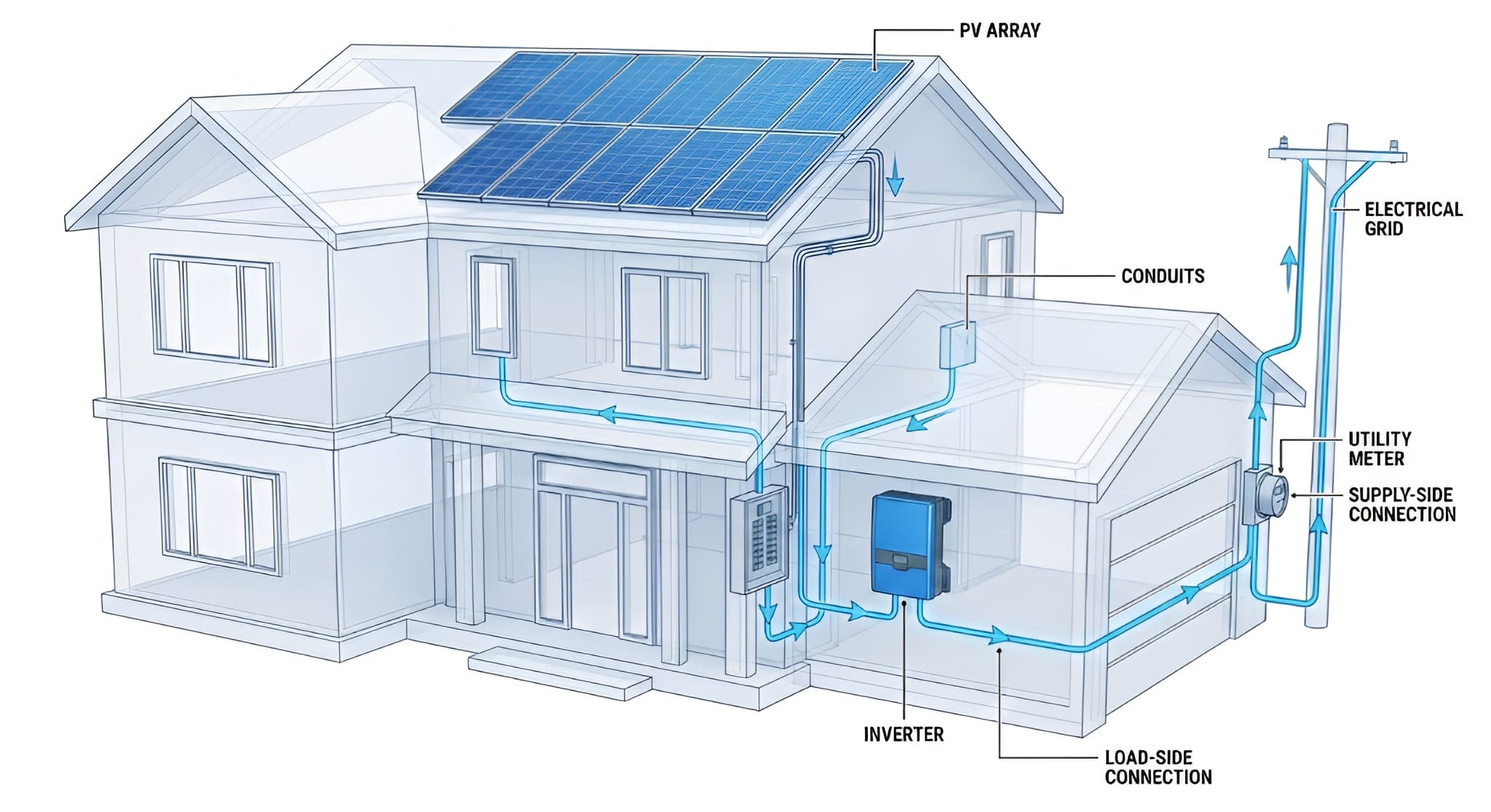

Solar interconnection refers to how a photovoltaic (PV) system connects to the electrical grid through either supply-side or load-side methods. Supply-side interconnection connects before the main service disconnect and is not limited by the 120% rule, making it ideal for systems 15kW to 50kW. Load-side interconnection connects after the main disconnect using a breaker and is the most common method for residential systems 7kW to 15kW, though it must comply with NEC 705.12(B)(2) busbar limitations.
The choice between supply-side (line-side) and load-side (breaker-based) interconnection determines system cost, installation complexity, permitting requirements, and NEC code compliance. Load-side connections offer simpler installation with no service disconnect modifications but are limited by the 120% rule. Supply-side connections bypass busbar limitations and support larger commercial installations but require utility coordination and service entrance modifications.
This guide explains both interconnection methods, when to use each approach, common inspection failures, and design best practices for solar professionals submitting plan sets to authorities having jurisdiction (AHJs).
Interconnection determines where the solar inverter output (AC side) connects into the existing electrical system, either:
Each method presents unique benefits, limitations, and NEC code implications.

This is the most common method for residential and small commercial PV systems. It connects the inverter output into the main panel or subpanel using a dedicated breaker.
For example: If a main panel has a 200A busbar and a 200A main breaker, the total backfeed from solar cannot exceed 40A (20% of 200A).
This means a 40A breaker can be used for PV (approximately 9.6 kW at 240V), unless the main breaker is downsized or a PV subpanel is added.

In this configuration, the PV output connects ahead of the main service disconnect, directly into the service conductors. This approach is common for off-grid systems transitioning to grid-tied.
This makes the solar system essentially a parallel service source to the utility feed.
When determining the appropriate interconnection method, the design should start with a panel schedule review. Key items to check include:
This analysis helps determine if a load-side connection is feasible or if a supply-side tap design is necessary.
Choosing between supply-side and load-side interconnection goes beyond convenience. It's about ensuring long-term system safety, passing inspections without redlines, and aligning with NEC standards and utility requirements.
By planning the connection strategy early, costly redesigns can be avoided, permitting time can be saved, and installation teams can stay focused on clean, compliant work.
What is the 120% rule in solar interconnection?
The 120% rule, outlined in NEC 705.12(B)(2), limits the total current sources (utility main breaker plus solar breaker) to 120% of the panel's busbar rating. For example, if a panel has a 200A busbar, the combined rating of the main breaker and solar breaker cannot exceed 240A. This rule only applies to load-side interconnections.
Can a supply-side connection be used for residential solar systems?
Yes, supply-side connections can be used for residential installations, particularly when the solar system size exceeds what the main panel can accommodate under the 120% rule. Requirements may vary by state, such as Texas solar permits. However, they typically require more coordination with the utility company and may involve higher installation costs due to service entrance modifications.
Where should the PV breaker be positioned in a load-side interconnection?
The PV breaker should be positioned at the opposite end of the busbar from the main breaker to ensure proper current distribution and comply with NEC requirements. Placing the PV breaker at the top of the panel bus near the main breaker can violate the 120% rule and result in inspection failures.
Do supply-side interconnections require utility approval?
Yes, supply-side interconnections typically require utility coordination and approval since they involve tapping into the service conductors before the main disconnect. Utilities often require sealed metering compartments and specific documentation to ensure the connection meets their standards and safety requirements.
What happens if the main panel cannot accommodate the solar system size?
If the main panel cannot accommodate the solar system under the 120% rule, there are several options: downsize the main breaker to create more capacity for solar, install a PV subpanel with its own breaker, or design a supply-side interconnection that bypasses the main panel entirely. The best solution depends on the specific project requirements, budget, and timeline. For complex scenarios, consulting with solar design experts or reviewing state-specific permit guides can help determine the optimal approach.
We are dedicated to providing top-notch solar permit services to homeowners, business owners, DIY, and solar installers. Contact us today.